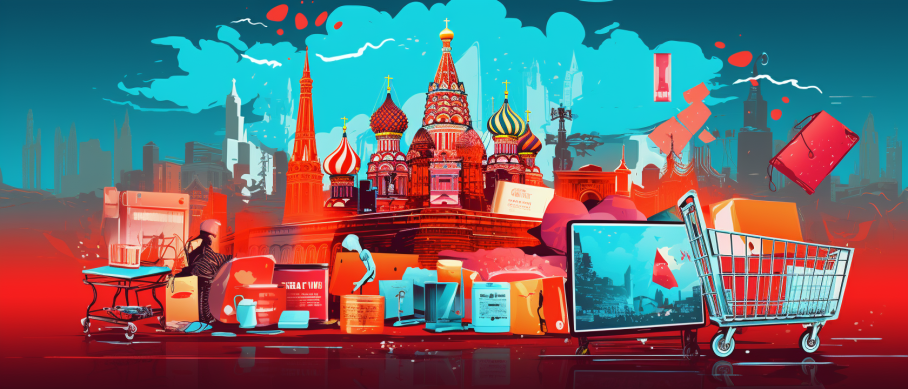It’s impossible to ignore: Online Shopping Surges Across Regions in Russia, moving from a niche activity to a mainstream habit. Let’s dive into the statistics and facts that paint this picture, drawing on reliable data and my own observations in the field.

The Profile of the Modern Russian E-Shopper
E-commerce has been present for over a decade, leading to a mature user base:
- Experience: A significant 44% have been ordering online for three to five years, and another 37% boast six to ten years of online shopping experience (Source: Statista). This indicates a high level of comfort and familiarity with digital platforms.
- Demographics: The largest group of online shoppers falls into the 35-44 age bracket, closely followed by those aged 25-34 (Source: Statista). While demographics vary across platforms, the gender split among marketplace customers is fairly balanced, with a slight majority of women (Source: Statista).
What Russians Are Buying Online: Popular Categories
Certain categories consistently top the charts in Russian e-commerce.
- Top Picks: Apparel, cosmetics, and body care products remain the most popular online purchases (Source: Statista). We see this reflected in platform strategies – about two-thirds of Russians prefer buying clothes online, and over 60% choose e-shops for these items specifically (Source: Statista).
- Grocery Growth: Interestingly, while footwear often still prompts an in-store visit (Source: Statista), Russia has achieved the second-highest penetration rate globally for online grocery delivery. Over half of the internet users I interact with or whose data we analyze have used these services (Source: Statista).
The Mobile Commerce Revolution in Russia
The shift to mobile is undeniable and a major driver of the overall surge:
- App Dominance: Russia consistently ranks among the top countries for shopping app downloads (Source: Statista). In 2023 alone, leading marketplace Wildberries saw around 30 million app installs, with competitor Ozon hitting 20 million (Source: Statista). Other popular apps include those from retailers like Sportmaster and L’Etoile (Source: Statista).
- Purchase Frequency: During Q3 2023, nearly 30% of Russian internet users made purchases via their mobile devices weekly, a figure aligning closely with the global average (Source: Statista). This highlights how integrated mobile shopping has become.
Unprecedented E-commerce Growth Across Russian Regions
The headline story is the sheer scale and reach of growth. It’s not just Moscow and St. Petersburg; Online Shopping Surges Across Regions in Russia, reaching even remote areas:
- Market Size & Recent Growth: The Russian e-commerce market demonstrated remarkable growth, hitting almost 9 trillion rubles ($98 billion) in 2024, a 41% jump from the previous year (Source: LinkedIn citing data). We saw consumers increase spending on online orders by over 25% in 2024, with some regions experiencing growth rates up to 80% (Source: bne IntelliNews). The average online marketplace receipt was 1,090 RUB in 2023 (Source: Statista).
- Regional Expansion: While megacities, particularly Moscow, remain leaders (Source: PayPal Inc. Study cited in PDF), the pandemic significantly spurred online shopping adoption across the entire country, including distant regions (Source: Law.asia). This expansion is reshaping logistics and delivery networks across Russia (Source: Statista).
Key Factors Fueling the E-commerce Surge
Several converging factors are driving this impressive growth trajectory:
- High Internet Penetration: With internet penetration around 88% (Source: Law.asia) and reaching 92.2% (133 million users) at the start of 2025 (Source: DataReportal), the foundation for online activity is solid.
- Digital Literacy & Payments: Growing digital literacy (Source: IMARC Group) combined with the proliferation of convenient online payment solutions like digital wallets and online banking(Source: IMARC Group) makes transacting online easier and more trusted.
- Business Adaptation: More companies are establishing robust online presences (Source: IMARC Group) , offering greater choice and competition.
- Infrastructure: The expansion of secure, user-friendly payment gateways tailored to the local market, alongside the integration of global solutions facilitating cross-border trade, is crucial (Source: IMARC Group).

Looking Ahead: The Future of Online Shopping in Russia
The momentum shows no signs of slowing down. Projections indicate a robust future for Russian e-commerce:
- Penetration Growth: The e-commerce penetration rate is expected to climb to nearly 40% by 2029 (Source: Statista).
- Mobile Expansion: Mobile e-commerce penetration is projected to reach almost 45% by 2028 (Source: Statista).
- Market Valuation: Forecasts suggest the overall market could grow 2.6-fold to reach approximately RUB 32.3 trillion (Source: Yakov & Partners), with a projected compound annual growth rate (CAGR) of 16% between 2025 and 2033 (Source: IMARC Group).
- Technological Enhancements: Despite challenges (Source: ReportLinker), advancements like Augmented Reality (AR) and Virtual Reality (VR) are expected to further enrich the mobile shopping experience (Source: Statista).
Conclusion
The data and trends are clear: Online Shopping Surges Across Regions in Russia is not just a headline, but a fundamental shift in consumer behavior and the national economy. Driven by experienced users, mobile adoption, expanding infrastructure, and growth reaching far beyond the major cities, Russia’s e-commerce market is dynamic, resilient, and poised for significant continued expansion. Keeping a pulse on these developments is crucial for anyone operating in or observing this exciting market.



